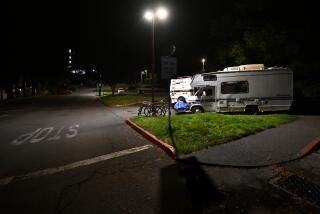Valley Commentary : A Risky Path for Pierce College : A sketchy proposal brings commercialism to an institution worthy of better public funding. But it may be the financially stretched college’s last best hope.
- Share via
Pierce College has its problems and now boasts the beginnings of a plan to address them.
The problems are well-known: Budget cuts have slashed programs; students can’t get classes needed for graduation; facilities are run down, and enrollment has dropped--which means still less money for the college.
The plan is less well-known and still in the formative stages.
In April, Mary Lee was transferred from Valley College to be acting president at Pierce and began to work with faculty, staff, administrators, homeowners, business organizations and elected officials to develop a master plan for the school. An early version was presented to the board of trustees of the Los Angeles Community College District at the end of July.
*
The plan so far exists only as an outline. Nothing has been published. One cannot examine projects or construction in terms of operations or costs. I was given the slide presentation that trustees saw and a tour of the campus and the college’s farm. The plan is certainly ambitious, but I am troubled by the thought of turning a large part the school into a commercial venture.
Mary Lee works from the premise that Pierce will never be adequately funded by the state and will have to raise its own money from private sources and revenue-producing activities, with perhaps some local taxes.
In addition to commercial enterprises on campus, success would require extensive community involvement and volunteer services ranging from conducting campus tours to designing new structures. It is assumed that only that combination can prevent the sale of many acres and further damage to the college.
The school will try to gain revenue in several ways:
* Profits will come from a golf driving range and a movie theater developed and operated by private enterprise.
* Facilities such as a community service center designed for conventions and an enlarged stadium would be used for the instructional program but could also be rented to businesses, community organizations and institutions. (Cicero Farms would continue to lease a corner of the farm.)
* A fitness center, an equestrian center with riding trails and walking and jogging trails would be used for instruction and would charge fees to community users.
Is such an approach compatible with a public college?
I prefer to begin with the premise that community colleges pay for themselves and should be fully funded because people with even one year of higher education are more likely to be employed, to earn more, spend more and pay more taxes than others.
Colleges with programs in agriculture benefit California’s $18-billion farming industry so directly that significant support should come from agribusiness, as it often does. With appropriate funding, Pierce could devote all time and energy to improving instruction rather than to writing and enforcing contracts.
In terms of instruction, my first concern was for the farm and agricultural program, but I was assured that none of the farmland would be lost. I was relieved that the intent is to preserve that wonderful natural resource against those who would cover all ground with concrete and to protect needed agriculture programs from those who haven’t observed the startling advances in plant science, animal science, food science, soil and water conservation and pest control.
A new health sciences building, a learning resource center and a student services center are expected to make the academic program more effective and the campus more appealing. A children’s science museum, a farm museum and a natural history museum would be used for college instruction, for tours by elementary and secondary students and for the public.
All those developments along with changes in the scheduling of classes are designed to address the problems of declining enrollment and deteriorating facilities. Such projects should indeed make the degree and certificate programs stronger.
Corollary purposes are to put the college, with its unique farm, among sites recommended to tourists by the Los Angeles Convention and Visitors Center and to attract leasing by motion picture production companies.
Will the results come? The approach is pragmatic if not visionary; the plan seems workable but difficult. Given today’s budgetary realities, there may be no other way. And all revenues would have to be used only at the college.
Pierce and the farm are too valuable an asset to the San Fernando Valley and metropolitan Los Angeles to lose. Pierce’s friends will be watching--and hoping.
More to Read
Sign up for Essential California
The most important California stories and recommendations in your inbox every morning.
You may occasionally receive promotional content from the Los Angeles Times.













